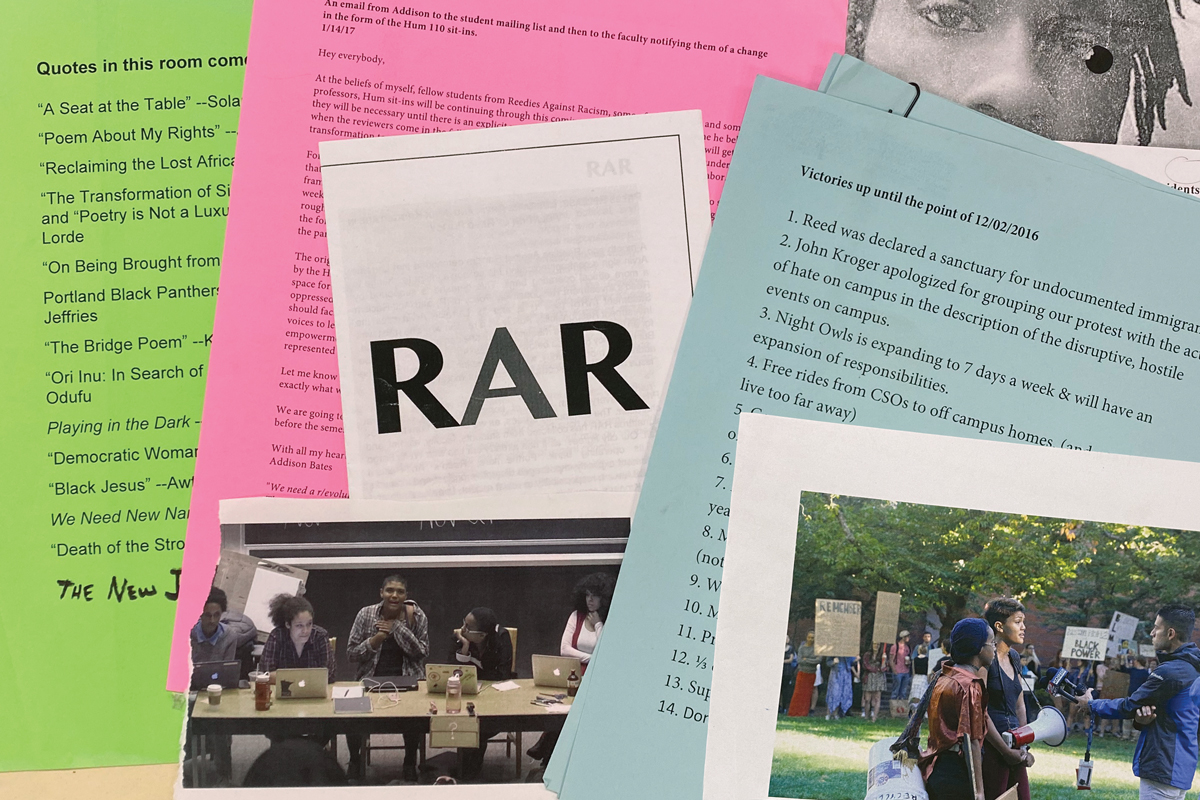Learning From the Past
Protestors in 2016 looked to the experience of an earlier generation—and adapted their tactics to suit new circumstances.
Dial your time machine to 2016. Intermittent protests were already commonplace across the nation in response to fatal police violence against unarmed Black people; a group of Reedies gathered on September 14th to stage a sit-in on the Quad in an action typical for a small college. But when another senseless death flashed across the headlines, actor Isaiah Washington called for a boycott of workplaces and classrooms nationwide.
Reed’s campus responded. Students and professors gathered in an impromptu Infoshop meeting so crowded it was standing room only. People shouted demands for a scribe to record on the Infoshop’s classically oversized paper. “It was interesting to see the range of what people wanted,” said Justice Storm del Castillo ’20, who was a freshman at the time. “And there was a bit of back and forth.”
Something like consensus formed around 26 demands that would later be levied against the school’s administration. Among them? Designate Reed as a legal sanctuary for immigrants. Draft an official anti-racism statement for the college. Create an ethnic studies program. Reboot Hum 110. And endow a social justice grant. A few days later, the group staged an open mic on the Quad and finally gave itself a name—Reedies Against Racism (RAR).
But how to achieve these goals? Over the next year and a half, RAR would deploy a wide array of tactics, ranging from traditional protests like rallies, teach-ins, and sit-ins to newer tools like YouTube and Facebook to enlist allies among alumni. Some tactics proved highly effective, while others—such as shutting down humanities lectures—backfired. Fundamentally, however, the campaign was rooted in the experience of a previous generation of activists.
“We were thinking about the ’60s,” said one RAR organizer, Addison Bates ’20. “I was in conversation with Ron Herndon ’70 a bit, one of the students who occupied in the ’60s.”
RAR members sought advice to avoid the pitfalls of previous student-led activist movements at Reed.
Lesson 1: Build on Past Successes. The work of previous generations of student and faculty activists was essential in putting some of their goals within reach. For example, the Multicultural Resource Center (created in 1993) provided a physical space on campus for Black and other historically underrepresented students. The Ad Hoc Committee on Diversity (2004) had been pushing for more diverse hires among the faculty. The Office for Institutional Diversity (2011) worked on creating a more inclusive campus. Student activism prompted the faculty to start planning an ethnic studies program in 2011. Each of these victories built critical momentum and showed that change was not only possible, but beneficial.
Lesson 2: Keep Up the Pressure. The protests of 1968 led to the creation of a Black studies program, but the gains were short-lived. Once the students moved on, the faculty was free to cut the program. A single rally wasn’t enough.
So RAR organized a series of silent protests at Hum lectures, where students displayed posters inside the lecture hall and sometimes occupied the stage (but did not interrupt the lecturer). The protests continued through the entire school year and served as a powerful reminder that the movement was not going away.
But the importance of persistence was underlined by RAR’s longest and most divisive tactic—the occupation of Eliot Hall. Activists had also targeted Eliot in 1968 and found it to be a vulnerable pressure point. “We got the faculty’s attention and I don’t think we would’ve if we hadn’t occupied Eliot Hall and wrote letters,” said Mary Frankie Forte ’71 of the sit-in she and others staged. “They can’t show up, they can’t go to work, they can’t teach class because we had Eliot Hall.”
Inspired by earlier generations of activists, RAR organized a similar action in October 2017, occupying the treasurer’s and president’s offices. But there was a key difference, which brings us to:
Lesson 3: Adapt. Previous occupations of Eliot had been all-or-nothing affairs. The protestors barricaded themselves inside and kept the doors shut. The all-in approach ratcheted up the pressure but was impossible to maintain for very long—after a few days, food ran low, tempers ran short, and there was the nagging issue of falling behind in your classes.
By contrast, RAR staged a much more fluid action. Protestors didn’t block administrators from their desks, but simply camped out in the offices and corridors, working on their laptops. They took turns going to class, taking showers, and eating meals in commons. This unusual and at times uneasy coexistence didn’t trigger a crisis so much as lay a siege—but it was a siege that lasted for months.
By the time the last students cleared out of Eliot in December, many of RAR’s goals had been either met or soon would be. President Kroger declared Reed a sanctuary campus. The college adopted an anti-racism statement. The faculty revamped Hum 110 to include a unit on the Harlem Renaissance and the history of Mexico City. The faculty also approved a program in comparative race and ethnic studies. Thanks to generous donors, Reed established a fund to support social justice work.
But if progress has a shape, it does not resemble a straight line; RAR’s list of demands now includes new improvements.
“I want students of color at Reed now to know that even with all these problems, it’s no one’s job to make the institution better—not students at least,” said del Castillo. “But the fact that people do try, I feel that’s meaningful.”
Tags: Alumni, Diversity/Equity/Inclusion, Reed History, Students
